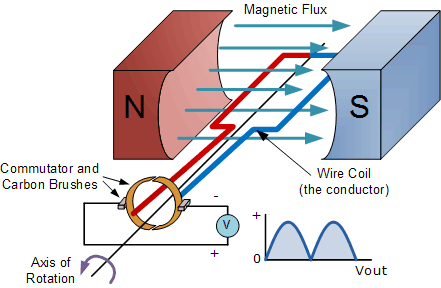Electromagnetic Induction (GCSE)
Why does a dynamo produce a direct current in an electromagnetic induction when a magnetic and coil when going back and forth produces a alternating current
Is it that the dynamo current spins around with the dynamo coil and the coil and magnet normal one goes in and out
If you know a good video to explain this please leave a link in the reply
GCSE Answer plz
Is it that the dynamo current spins around with the dynamo coil and the coil and magnet normal one goes in and out
If you know a good video to explain this please leave a link in the reply
GCSE Answer plz
Original post by Kingland
Why does a dynamo produce a direct current in an electromagnetic induction when a magnetic and coil when going back and forth produces a alternating current
Is it that the dynamo current spins around with the dynamo coil and the coil and magnet normal one goes in and out
If you know a good video to explain this please leave a link in the reply
GCSE Answer plz
Is it that the dynamo current spins around with the dynamo coil and the coil and magnet normal one goes in and out
If you know a good video to explain this please leave a link in the reply
GCSE Answer plz

Any conductor cutting magnetic lines of flux will generate an e.m.f.. The polarity of the e.m.f. is determined by the magnetic poles and direction of movement of the conductor in the magnetic field. i.e. as the conductor rotates it alternates between moving across the field (lines of flux are cut) and then parallel to the field (no lines of flux are cut) to create an a.c. output.
A.C. GENERATOR:

D.C. GENERATOR (DYNAMO):
The dynamo has the same components as an a.c. generator with one exception: it uses a commutator (segmented slip-ring) to rectify the current produced such that it now all flows in the same direction. (See video link at the bottom)
SINGLE COIL DYNAMO (D.C. MOTOR):

In practice, d.c. generators use multiple coils spaced evenly around the rotor, with a multiple commentator segments. Each individual coil produces a fully a.c. output.
The multi-segmented slip-ring and a pair of carbon brushes allow the current from each coil to be picked off one by one in turn as the coils rotate in and out of the stationary permanent magnetic field. i.e. the e.m.f. across each coil is picked off one after the other. Because there are many coils evenly spaced, the e.m.f. developed across any individual coil cannot vary significantly before the next coil takes it's place.
In this way, the combined e.m.f. picked off in succession from all of the coils, produces a succession of e.m.f. peaks all linked together which mimicks a constant d.c. output.
Look closer at the dynamo output and you will notice the e.m.f. is not constant but has a voltage ripple component.
[video]https://youtu.be/ATFqX2Cl3-w[/video]
(edited 9 years ago)
Split ring commutator causes the terminals that the wire is in contactbwith to swap every half turn, reversing the current , which is necessary tokeep the thing spinning in the same direction
Posted from TSR Mobile
Posted from TSR Mobile
Original post by Kingland
What is the purpose of the carbon brushes and the slip rings
This mechanism allows the current generated by the rotating coil to be picked off and fed via conducting cables to where the current is needed. i.e. lamps, speedometer etc.
Take a look at this video. The slip rings and brushes on the generators (small power station) are very big because they need to handle a lot of power. The dynamo slip rings and brushes work on exactly the same principle but are far smaller because they do not need to handle a lot of power.
[video]https://youtu.be/P83Qa3Chb7I[/video]
Quick Reply
Related discussions
- A level physics- Further mechanics question (1)
- How exactly does step up/down transformers work?
- Please give me physics resources
- GCSE Physics AQA Topic 7 (Electromagnetism) I need help!!!
- can someone help me with gcse physics
- What is the hardest topic in GCSE phyiscs?
- Can Kaon+ experience the Electromagnetic interaction?
- WJEC GCSE Biology Unit 1 Higher Tier [13th June 2023] Exam Chat
- GCSE Physics Electromagnetism Question (5 Marks)
- Physics Alevel question :- electromagnetism induction and alternating current
- Next Induction Day and Wage?
- AQA GCSE Physics Spec
- Physice revision?
- Physics A Level Question Forces - electromagnetic and electrostatic force
- Gcse combined science higher paper 2 physics
- GCSE Physics Electromagnetism
- Physics MCQ
- Igcse physics paper 1 june 2023 edexcel | exam chat
- Can I get into Dentistry with a 5 in English
- Ocr a physics 2023 grade boundaries



